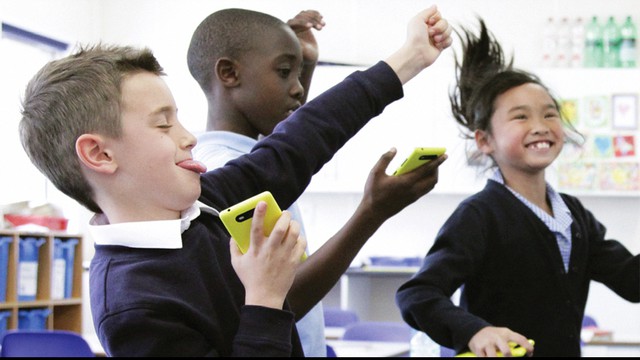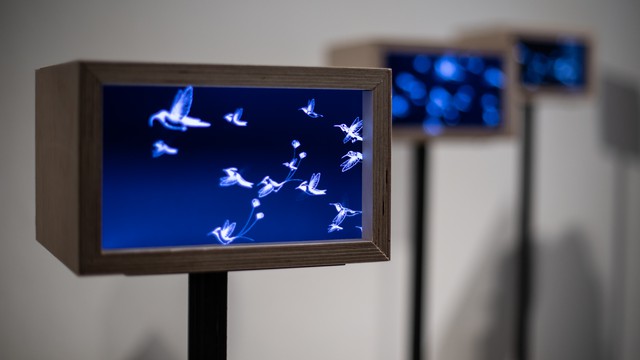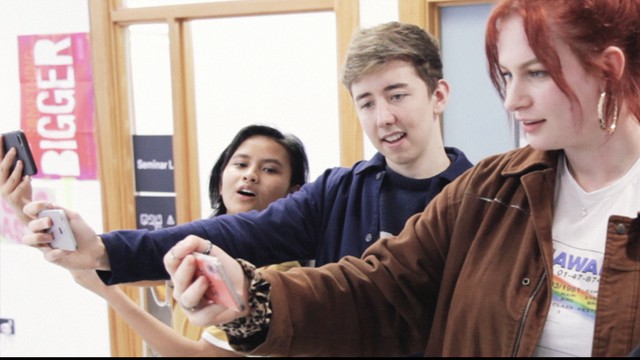Hummingbird 2020, United Kingdom, London
A multi-channel installation for the gallery, the home, classroom or outdoors, which tells the cautionary tale of hummingbird classification and AI.




Throughout history the arts have influenced society and culture. However, art is consistently undervalued in education, and in many low income countries, art teaching is almost non-existent. ‘Hummingbird’ is a digital platform that presents educational, artistic and immersive experiences using ubiquitous devices such as basic smartphones, tablets and computers. For this first experience, the platform transforms a number of these devices into an immersive multi-screen artwork with synchronised video and sound, for the classroom, home or outdoors. The piece tells the cautionary tale of hummingbird classification and AI. To demonstrate the platform in a gallery or museum setting, I have also developed a physical installation that encases six screens and speakers in wood and metal structures.
The Warwick Commission found that there has been up to a 50% drop in GCSE entries for arts courses in the UK. This often leaves cultural experiences such as gallery visits inaccessible to young people without parental interventions. This problem is worse outside of major cities. Whilst there has been great progress in achieving universal primary education in low income countries, arts education is often non-existent. I am passionate about democratising the arts and culture. The creative use of ubiquitous technologies like mobile phones presents exciting opportunities for us to overcome traditional barriers to accessing art such as age, geography, socioeconomic and disability status. Covid-19 has accelerated the need for art to be accessible outside of traditional inner city spaces. 'Hummingbird' is about enabling young people to meaningfully engage with art together, rather than just view representations of it online in sedentary isolation. I plan to host more multi-channel video works, as well as artworks involving spatial sound, augmented reality, and virtual reality (all accessible on ubiquitous tech). I will continue to trial the platform in UK schools, with the ambition to launch the platform internationally. The first project on the platform is called 'Trochilidae' or 'Hummingbird'. Hummingbirds have puzzled scientists for centuries by defying classification. Their complex history serves as an allegory for the wider challenges we face today in artificial intelligence and classification. Lessons from this cautionary tale become increasingly urgent as AI technologies are introduced into vital services like policing and healthcare. The project explores these complex themes through scripted dialogue, orchestral composition, spatial audio, and multi-screen animation - all through phones.
Details
Team members : Jack Hardiker
Supervisor : Academic Supervisors: Dr Eleanor Dare, Dr Matthew Lewis, Rachael Finney
Institution : Royal College of Art
Partners : AFEW Development, Scott Lockhart Animation, Philip Kay Composition, Joe Morris Art Fabrication.
Descriptions
Technical Concept : 'Hummingbird' is a web app available on smartphones, tablets and computers, that synchronises multi-screen animation and spatial audio across a number of these devices. The use of web technologies rather than a native app increases the accessibility of the platform. Anyone with a web browser can access the platform. 'Trochilidae' is the first project on the platform. To test the educational storytelling capabilities of the system, I used animation, music and narration to explore a link between hummingbird classification and the racial biases found in some Artificial Intelligence technologies. For this piece, six people access the platform on phones and start a session. This synchronises their devices, enabling them to view a multi-screen artwork across their phone screens. The platform also provides a spatial sound experience, with each phone playing a different audio track.
Visual Concept : The current iteration of the platform allows for multi-screen video and multi-channel audio. 'Trochilidae' uses an anthropological illustration style in the animation, to match the theme of the work. The animations are presented white on black. The piece is accompanied by a multi-channel orchestral soundtrack that I co-created with the composer Philip Kay. Each phone has a different instrument coming from its speaker. A narrator explains the significance of the hummingbird's story in relation to AI technologies. I also developed a physical installation to demonstrate the platform in a gallery or museum setting. Six screens and speakers are elegantly encase in wooden 'hummingboxes' on custom metal structures, disguising the networked circuits and wires beneath.
Credits
J.Hardiker
J.Hardiker
J.Hardiker & T.Eigeland
J.Hardiker
J.Hardiker
J.Hardiker